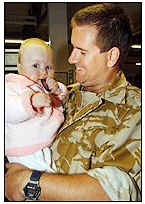
| Orion crew cool
down after Gulf mission
|
| Sergeant Tony Adolph with daughter Madison Taylor. Picture / Fotopress |
| 23.07.2003 |
| By SCOTT MacLEOD For eight hours in the baking heat of the Gulf, a Royal New Zealand Air Force Orion skims barely 150m above the waves as its crew photograph up to 110 ships. The vessels range from cargo dhows and fishing boats to supertankers. Some - maybe 20 a day - prove to be suspect. Warships such as the NZ frigate Te Mana are sent to check for "terrorist support activities". This is a typical day for the New Zealanders, who are in the Gulf to support the American-led Operation Enduring Freedom. Yesterday, 19 members of the Orion crew returned home for a rotation after more than two months patrolling the Gulf of Oman and Arabian Sea. The Orion flew every second day with a 100 per cent success rate, the crew said. Before it took to the air, ground staff would "cold soak" the Orion - hook it up to a jumbo jet air-conditioner to cool the interior to a bearable 31C. Compare this with the 65C recorded on the tarmac one day and it is easy to see why the Orion's wings are marked by footprints from melting boots. During flights the on-board air-conditioner made clouds of condensation that drifted in the flight deck. "We sit in a layer of dust and sand that plays havoc with our equipment," Wing Commander Carl Nixon said. "On an eight-hour flight the pilot rarely gets out of his seat because we rarely get above 500 feet. Everybody has to be strapped in, and that's more demanding than at home, where we sometimes climb to 5000 feet." Despite the melting boots and other small problems, Wing Commander Nixon said the Orion had performed well and had easily integrated with the 15 other ship-spotting planes in the Gulf. He said the Orion crew did not know why the Americans were interested in some of the vessels. Squadron Leader Ric Cullinane said the Orion's submarine-spotting abilities had not been an issue because the Orion was meant to spot only ships in the Gulf. "The task is very similar to a New Zealand economic zone patrol - identifying and monitoring surface vessels. A lot of it is visual." After each flight the ground crew washed the Orion with fresh water and soft brushes to remove thick layers of dust. Oil made runny from the heat seeped from the aircraft and was harder to budge. A second Orion and 19 crew left Whenuapai on July 15 to take over from their colleagues. Herald Feature: Defence |